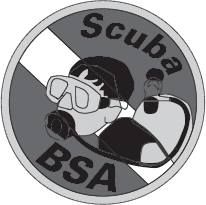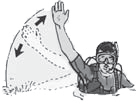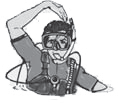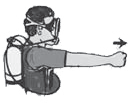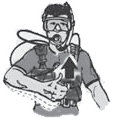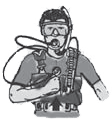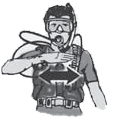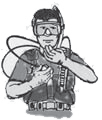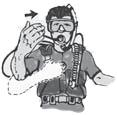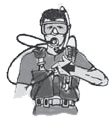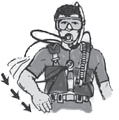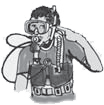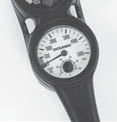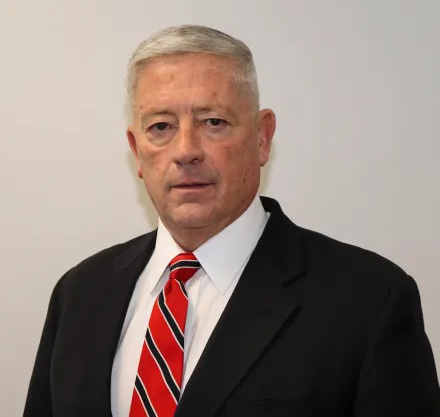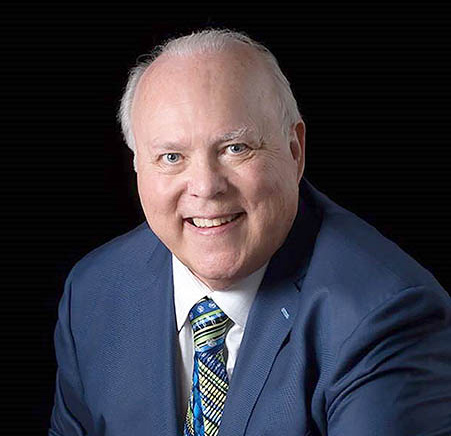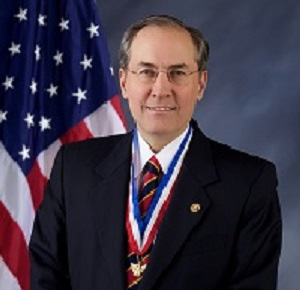Scuba BSA PDF With Application
Scuba BSA introduces qualified Scouts BSA, Venturing, and registered adult participants to the special skills, equipment, and safety precautions associated with scuba diving.
Scuba BSAScuba BSA introduces qualified Scouts BSA, Venturing, and registered adult participants to the special skills, equipment, and safety precautions associated with scuba diving; encourages aquatics activities that promote fitness and recreation; and provides a foundation for those who later will participate in more advanced underwater activity. The Scuba BSA experience contains two parts— Knowledge Development and Water Skills Development. During the first part, participants learn basic dive safety information and overview skills to be used during their water experience. The Water Skills Development session introduces essential dive skills, such as mask clearing, regulator clearing, and alternate air source use. The Scuba BSA program is conducted in clear, confined water by an instructor certified by diving organizations recognized by Scouting America. Completion of Scuba BSA requirements sets the stage for additional training but does not qualify the participant to dive independently, either in confined water or open-water environments. Scuba BSA is not a diver certification. |
Scuba SafetyScuba diving is an advanced swimming activity. Safe Swim Defense guidelines, as found in the Guide to Safe Scouting, apply, but must be extended to cover underwater communication, the use and care of equipment, buoyancy control, and the effects of pressure. The following discussion highlights safety issues that will be covered during Scuba BSA instruction, and also identifies important safety concerns that may not be covered in this introductory scuba experience. While Scuba BSA is designed to be educational as well as fun, it is important for you to realize that neither the material in this brochure, nor completion of the requirements, provides you with the necessary knowledge and experience to participate in any scuba activity other than additional training courses conducted by certified instructors. While the Scuba BSA program is open to qualified participants of Scout age, additional scuba training as a BSA activity is limited to those 14 or older. |
||||||||||||||||||||||||||||||||||||||||||||||||||||||||||||||||
Qualified SupervisionYour Scuba BSA experience will be conducted by a certified instructor following standards established by the Recreational Scuba Training Council and additional BSA guidelines provided in the Information for Counselors section. Any additional scuba training you receive should also be conducted by an instructor certified by a recognized agency. Even though your friends may be certified as open-water divers and have access to equipment, they should not offer, nor should you accept, any invitation to dive unless you are also certified. If you and others in your unit do become certified, any dive trips as a unit must be supervised by adults with divemaster or higher rating. |
Personal Health ReviewYour Scuba BSA instructor will ask you to complete the Annual Health and Medical Record, No. 680-001. Certain responses on that form may require that you get a physician’s approval before you are allowed to use equipment in the water. Those with chronic disease or physical disability may still be able to enjoy and benefit from a scuba experience if the instructor is aware of the condition and approval has been obtained from a licensed physician. You will learn during Scuba BSA or more advanced instruction that you should postpone diving activities if you are suffering from a cold or sinus condition that causes temporary congestion. This is necessary because of the effects of pressure. |
||||||||||||||||||||||||||||||||||||||||||||||||||||||||||||||||
Safe AreaInstruction for Scuba BSA will be done either in a pool or at an established waterfront swimming area with poollike visibility. Safety in open water requires consideration of several factors such as water clarity and temperature, currents, surf, boat traffic, and marine life, including vegetation. Learning how to deal with such variables is an important aspect of diver certification programs.
|
Emergency PreparednessSafe Swim Defense specifies lifeguards and lookouts as members of a rescue team that recognizes and deals with emergency situations. Those functions will be assumed by your instructor and his or her assistants during Scuba BSA instruction. The Scuba BSA requirements will introduce you to techniques for sharing air while underwater. Additional skills to aid a buddy in distress are covered in more advanced courses. It is important that you receive such training before you dive in open water. The divemaster or another person providing underwater supervision during open-water dives will be trained to handle emergencies. In addition, group dives often have surface support personnel who are also prepared to assist divers in distress. |
||||||||||||||||||||||||||||||||||||||||||||||||||||||||||||||||
AbilityYou must first complete the BSA swimmer classification test before you work on other Scuba BSA requirements. Initial comfort and confidence in the water, as indicated by reasonable swimming ability, is a first step to enjoyment of the underwater world opened by the use of scuba. You will need to gain additional abilities through instruction and experience before you become a competent scuba diver. |
Buddy SystemSkilled divers never dive alone. The buddy system allows two people to enjoy an aquatics activity together while each provides a critical margin of safety for the other. Each buddy must constantly be aware of the condition and circumstances of their buddy and always ready to call for aid or to assist if needed. Before a dive, buddies help each other fit and check their equipment. Your use of the buddy system for scuba diving will begin with Scuba BSA instruction. |
||||||||||||||||||||||||||||||||||||||||||||||||||||||||||||||||
CommunicationThe ability to communicate with each other is an important part of the buddy system. Scuba divers seldom have the special equipment needed to speak to one another while underwater. It is therefore important that you learn the standard hand signals used by scuba divers. Your instructor will teach you these as part of the Scuba BSA program. Photos of the signals are included to serve as a learning aid. |
EquipmentSafe diving requires that you know how to check, use, and maintain special equipment. Scuba BSA will introduce you to the proper use of basic scuba equipment. Additional knowledge of your equipment, as provided in certification courses, is needed before you are ready for open-water diving. |
||||||||||||||||||||||||||||||||||||||||||||||||||||||||||||||||
Buoyancy ControlBuoyancy control is important for safe, as well as enjoyable, diving. Certified divers are able to “hang” without movement at any given depth. That is, they don’t need to use their fins to keep from either sinking or popping to the surface. This is done by adding and subtracting air from a buoyancy control device (BCD). Scuba BSA will introduce you to the use of a BCD. Your BCD can also be used as an emergency flotation device at the surface. |
Understanding PressureAn apparently simple action such as holding your breath during an ascent can cause problems due to the interactions of water and air pressure with your body. You will be introduced to proper compressed air breathing techniques and how to perform a safe ascent as part of Scuba BSA. Other critical aspects of safe open-water diving, such as how long you can safely remain at what depth, are not covered during Scuba BSA instruction. |
||||||||||||||||||||||||||||||||||||||||||||||||||||||||||||||||
DisciplineSafety procedures are effective only when they are followed. It is the joint responsibility of both the dive supervisor and each individual to maintain safe attitudes and actions. Your instructor and buddy should both be able to assume that you are trustworthy, helpful, and obedient. |
Snorkeling BSAScuba provides exceptional freedom to explore the underwater world. However, there is often much to see near the surface. While you wait for the opportunity to expand your scuba skills, you may wish to earn Snorkeling BSA. |
||||||||||||||||||||||||||||||||||||||||||||||||||||||||||||||||
CommunicationThese are standard scuba hand signals that are useful above and below the surface. You will learn these as part of your Scuba BSA experience. Hand signals used with express permission of International PADI, Inc. © International PADI, Inc.
|
|||||||||||||||||||||||||||||||||||||||||||||||||||||||||||||||||
Understanding PressureIf you dive rapidly to the bottom of a swimming pool without a scuba tank, you are likely to notice pressure, or pain, against your ears. If you swallow, or wiggle your ears, the feeling may go away. Your body is accustomed to a pressure of one atmosphere (the weight of the column of air from sea level to outer space) of around 14 pounds per square inch. Since water weighs much more than air, pressure underwater increases rapidly with depth. Every 33 feet or so, you add another atmosphere. As you descend, the water pressure outside your chest squeezes your lungs, and raises the air pressure inside them. If air is free to move from your lungs to your inner ear, the pressure of the air on the inside of your eardrum will match the pressure of the water on the outside, and you won’t feel any difference in pressure. If the Eustachian tubes that connect your lungs to your inner ear are blocked, the air pressure in your inner ear remains the same as that at the surface, and pain will warn you of the mismatched pressure. |
Sound complicated? Don’t worry; even if you don’t understand the details, your instructor will still show you how to equalize pressure in your ears. However, if you have a cold with nasal or sinus congestion, you may not be able to do so, and you should not dive until the congestion clears. You will not feel pain or discomfort if you equalize properly. If you do feel discomfort in your ears, stop descending and signal your instructor. If you dive to the bottom of the pool while breathing from a scuba tank, you still need to clear your ears, but the situation is different. The pressure in your lungs increases not because they are squeezed, but because your air supply is under pressure. You breathe through a special valve, or regulator, that changes the air pressure from your tank to match what you need at a given depth. Breathing air under pressure can cause problems if you hold your breath as you change depth. You need to release the pressure in your lungs as your ascend to prevent possible damage to delicate lung tissue. That leads to the most important rule while scuba diving: Never hold your breath. |
||||||||||||||||||||||||||||||||||||||||||||||||||||||||||||||||
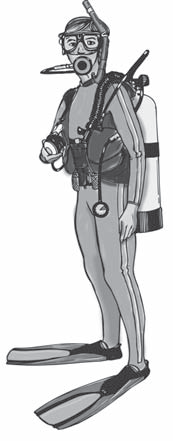
The volume of air in your BCD controls your buoyancy. As you change depth, the water pressure changes, and air in the BCD expands or contracts. You either need to add or remove air to control your buoyancy at a new depth. You probably know from your experience with carbonated drinks that liquids can hold dissolved gases. The greater the pressure, the more gas the liquid can absorb. If you breathe air under pressure for long periods, your blood will absorb some of the air. If the pressure of the air you are breathing is then reduced too quickly, air bubbles may form in your blood and cause various decompression problems. You don’t need to be overly concerned with such problems for the times and depths you will encounter with Scuba BSA. However, you risk serious injury if you use scuba equipment on your own without proper training and understanding of the effects of pressure. |
EquipmentA mask provides an air space to improve vision. Mask designs allow for pressure equalization. A snorkel provides an alternate breathing technique at the surface. A regulator supplies air on demand at the proper pressure. A buoyancy control device (BCD) allows the diver to remain stationary at a given depth. Air can be added to the BCD either from the tank or orally, using an inflator. A pressure gauge measures the air supply in the tank. Other instruments mounted on a console, hose, or wrist include a depth gauge for measuring depth, a compass for navigation, and a dive computer that monitors how long the diver can safely spend at a given depth. An extra regulator, or octopus, provides a secondary air source from the same tank. A weight belt, in combination with the BCD, adjusts buoyancy. A valve at the top of the tank supplies high-pressure air to the regulator via a hose. Fins greatly improve the power from swimming. Protective clothing may include booties, gloves, skins, and a partial wetsuit or a full wetsuit. Pressure gauges comein a number of designs, but all indicate when the air supply is low.
|
||||||||||||||||||||||||||||||||||||||||||||||||||||||||||||||||
|
FLORIDA NATIONAL HIGH ADVENTURE SEA BASEThe Florida National High Adventure Sea Base in the Florida Keys offers several exciting programs, including scuba certification. For more information, visit |
|||||||||||||||||||||||||||||||||||||||||||||||||||||||||||||||||
BSA Scuba PolicyThe BSA scuba policy recognizes scuba industry standards and implements them by using outside agencies for training and certification. Training and Supervision Recreational diving activities by BSA groups must be supervised by a responsible adult currently certified (renewed) as a divemaster, assistant instructor, or higher rating from a recognized agency. Dive environments, equipment, depths, procedures, supervision, and buddy assignments must be consistent with each individual’s certification. Because dives by recreational divers may be infrequent, the divemaster or instructor supervising a BSA scuba activity should screen participants prior to open-water activities and provide remedial instruction and practice as appropriate. Such remedial instruction and practice should be in accordance with the policies and standards of the divemaster’s or instructor’s agency for Scuba Review, Scuba Refresher, or similar program. Diving using surface-supplied air systems is not authorized in connection with any BSA activity or facility except when done under contract by commercial divers. Medical Contraindications The divemaster or instructor supervising a BSA recreational scuba activity must review the health information for each participant that is required annually of all BSA members on the Annual Health and Medical Record, No. 680-001, and evaluate risk conditions using medical standards consistent with those used by his or her certifying agency. Additional tests or physician consultations may be required to confirm fitness for diving. Consultation with medical specialists knowledgeable about diving medicine also may be needed for participants taking psychotropic drugs for treatment of attention deficit disorder, depression, or other conditions. Scuba diving is prohibited for the following conditions:
The scuba agencies recognized by Scouting America may allow exceptions to general medical prohibitions based on individual diving fitness evaluations by a medical specialist who is knowledgeable about diving medicine. Scouts, parents, dive supervisors, and physicians with questions or concerns about diving with specific medical conditions should consult the Recreational Scuba Training Council (RSTC) Guidelines for Recreational Scuba Diver’s Physical Examination and the Divers Alert Network (DAN) at www.diversalertnetwork.org. DAN medical professionals are available for nonemergency consultation by telephone at 919-684-2948 during business hours or through the contact form on the Divers Alert Network website. |
Age-Appropriate Restrictions Members of Scouts BSA may participate in the introductory Scuba BSA program and may obtain open-water certification as part of Scuba Diving merit badge. Venturing groups may participate in introductory and certification scuba programs conducted by recognized agencies appropriate to their ages and current levels of certification. Standards of the recognized scuba agencies require students for open-water certification programs to be at least 15 years of age but allow special certification programs for younger students. Since all instruction for BSA scuba programs must be conducted by professionals certified by a recognized agency, additional agency-specific, age-related restrictions and protocols apply to students under 15 years of age. Scouts, and Venturers may participate in recreational group dives as unit, district, or council activities, provided such dives are consistent with their certifications and under direct, on-site supervision of a responsible adult currently certified as a divemaster, an assistant instructor, or a higher rating from a recognized agency. The divemaster or instructor supervising a recreational dive by a BSA group must implement the following policies for all divers under 15 years of age, as well as any additional junior diver restrictions and protocols adopted by that person’s certifying agency:
Council Programs Local council programs may not compress or sell air for scuba use, or sell, rent, or loan scuba equipment (e.g., scuba cylinders, regulators, gauges, dive computers, weights, or BCDs). All air and equipment for local council program use must be obtained from professional sources (e.g., dive stores, resorts, dive boats, etc.) affiliated with a scuba agency recognized by Scouting America. Scuba equipment may be used by certified summer camp aquatics program personnel for installation and maintenance of waterfront equipment, or for search and recovery operations. Search and recovery could include lost equipment, as well as rescue efforts. Recognized agencies are:
In addition to the agencies listed by name, any current member of the World Recreational Scuba Training Council (WRSTC), which includes all Recreational Scuba Training Council (RSTC) members, is also recognized. Other agencies wishing to be recognized by Scouting America may contact the Outdoor Programs Team of the national office. Recognition by a certifying body such as the RSTC or European Underwater Federation (EUF) that the agency adheres to ANSI/CEN/ISO standards would be expected. For the most recent version of the BSA Scuba Policy, visit the Guide to Safe Scouting at www.scouting.org/scoutsource/healthandsafety/gss/toc.aspx. |
||||||||||||||||||||||||||||||||||||||||||||||||||||||||||||||||
BSA ApplicationYou can print out page 11 and 12 on this Scuba BSA PDF With Application and follow the requirements, instructions, and guidelines to be a part of the scuba program. |
|||||||||||||||||||||||||||||||||||||||||||||||||||||||||||||||||
INFORMATION FOR COUNSELORS |
|||||||||||||||||||||||||||||||||||||||||||||||||||||||||||||||||
|
Counselors for Scuba BSA must hold current scuba instructor certification from PADI, NAUI, SSI, or other RSTC member organizations. Instruction must comply with RSTC standards for introductory scuba experiences. These minimum standards include instructor-to-participant ratios. In a pool, the ratio is eight participants per instructor. In a confined waterfront setting, the ratio is four participants per instructor. Ratios may be increased by two participants if the instructor is assisted by someone certified as a divemaster or assistant instructor. A second adult who understands the procedures should be present in case the instructor becomes incapacitated. Two-deep adult leadership is also required by BSA Youth Protection policies. Before participants are allowed in the water, they must complete a health history form designed for scuba activities. Instructors should use standard forms advocated by their certifying agency. Skill instruction must be conducted in clear, confined water. A swimming pool is recommended. Scuba BSA is ideally suited to winter programs using indoor pools. Two 45-minute sessions are recommended for instruction, practice, and completion of requirements. |
Although Scuba BSA is similar to introductory scuba experiences offered by various RSTC member organizations, those programs are not substitutes for Scuba BSA. All requirements must be completed as stated on the application form. The counselor may not omit, vary, or add requirements. In particular, Scuba BSA has a prerequisite swimming requirement, is only available to youth and adults registered in the Boy Scouting or Venturing programs (minimum age around 10 1/2), and does not include the option of an open-water dive. Local council programs may not compress or sell air for scuba use, or sell, rent, or loan scuba equipment. All air and equipment for local council Scuba BSA programs must be obtained from properly licensed sources, unaffiliated with Scouting America and under the supervision of PADI, NAUI, SSI, or other RSTC-approved and certified scuba instructors. Individuals completing the Scuba BSA requirements qualify for a recognition card and patch. The counselor or unit leader should submit the completed award application to the local council service center. |
||||||||||||||||||||||||||||||||||||||||||||||||||||||||||||||||
|
*The counselor for Scuba BSA must hold an instructor rating and be in current teaching status with PADI, NAUI, SSI, or other member of the RSTC in accordance with BSA scuba policies. Instruction must meet the minimum training standards for introductory scuba experiences set by the RSTC and guidelines provided in the Scuba BSA pamphlet, No. 430-515. BSA scuba policies are also provided in the Guide to Safe Scouting. |
|||||||||||||||||||||||||||||||||||||||||||||||||||||||||||||||||


